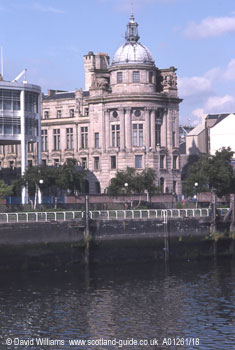The city`s heyday was in the late Victorian period. By that time, Glasgow had built up an enormously powerful industrial and commercial base and was able to sell `high-tech` manufactured goods all over the world; in addition, these exports (from steel nails to massive railway locomotives) were transported abroad in Clyde-built ships and the financial and insurance arrangements were often made by Glasgow banks and insurance companies. Glasgow was now `The Second City of the Empire` and since Britain was at that time the greatest imperialist power the world had ever seen, many Glaswegians saw themselves as citizens of the second most important city in the world.
The Victorians were brimful with confidence. They had found success in
manufacturing and trading, they had conquered much of the world and they
celebrated their achievements by erecting often ostentatious buildings
in which to work, live and meet. The glories of ancient empires were recalled
through the prominent statuary on the bigger buildings. The
City Chambers in George
Square, the Clyde
Navigation Trust at Broomielaw (see
picture)
and the St Andrew`s Halls near Charing Cross are all well-known buildings
which are decorated with large statues depicting Greek gods as well as
other Classical statues representing the Arts, Sciences and the achievements
of Glasgow and the British Empire. The leading citizens saw Glasgow as
a city with a very international perspective and this was reflected in
two major events: the 1888 International Exhibition and the 1901 International
Exhibition, both of which were held in Kelvingrove Park.
In the late-Victorian period the city`s middle class had never had it
so good; they lived in substantial stone houses, they had leisure time
to enjoy and well-stocked `warehouses` (department stores) in which to
buy the luxuries that others could only dream about. Some of these large
shops, such as Wylie & Lochhead in Buchanan Street, stocked high-quality
goods from all around the world but many of their expensive household
goods, such as furniture and carpets were made either by themselves or
by other Scottish manufacturers. These firms were involved in making furnishings
for the luxury ships which were built on the Clyde and they used this
expertise to be able to supply customers with the contents of complete
dining rooms or parlours, no matter whether the purchaser lived in Glasgow
or wanted to have everything shipped abroad to some far-flung corner of
the Empire.
This article is based on the guidebook "The Glasgow Guide".
